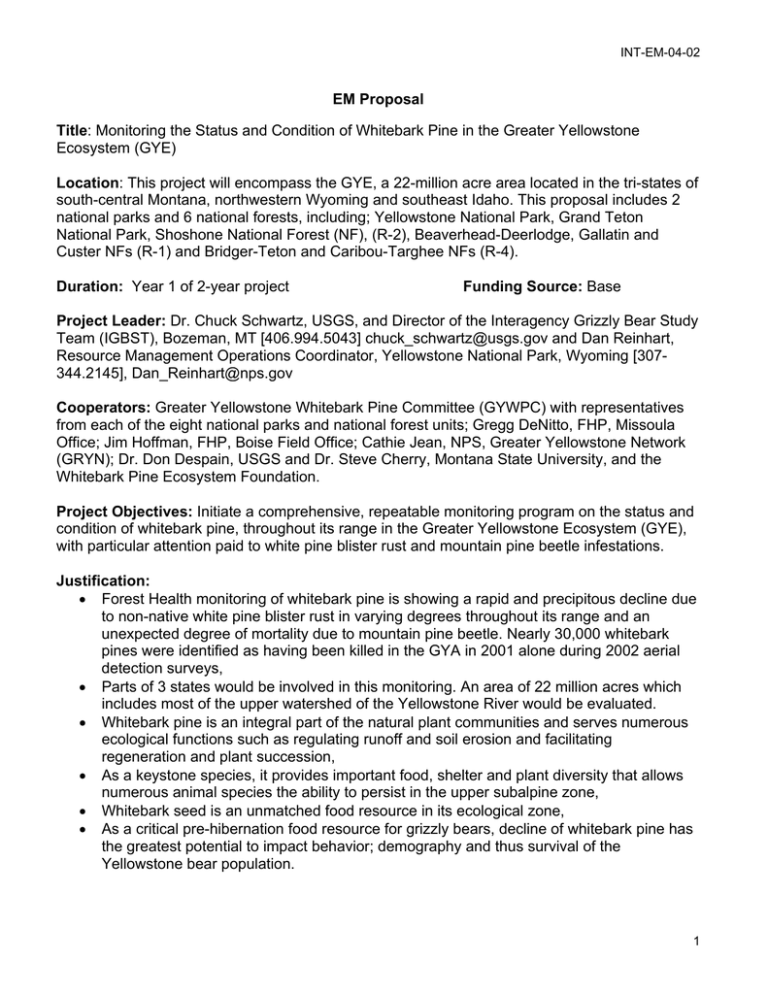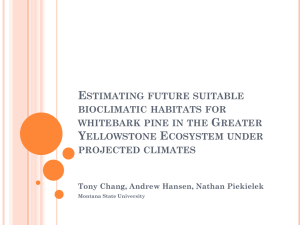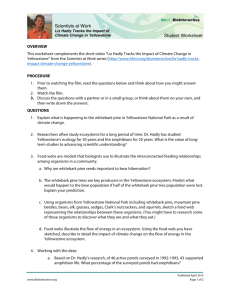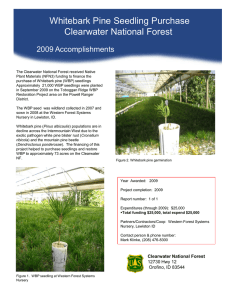EM Proposal Title Location Ecosystem (GYE)
advertisement

INT-EM-04-02 EM Proposal Title: Monitoring the Status and Condition of Whitebark Pine in the Greater Yellowstone Ecosystem (GYE) Location: This project will encompass the GYE, a 22-million acre area located in the tri-states of south-central Montana, northwestern Wyoming and southeast Idaho. This proposal includes 2 national parks and 6 national forests, including; Yellowstone National Park, Grand Teton National Park, Shoshone National Forest (NF), (R-2), Beaverhead-Deerlodge, Gallatin and Custer NFs (R-1) and Bridger-Teton and Caribou-Targhee NFs (R-4). Duration: Year 1 of 2-year project Funding Source: Base Project Leader: Dr. Chuck Schwartz, USGS, and Director of the Interagency Grizzly Bear Study Team (IGBST), Bozeman, MT [406.994.5043] chuck_schwartz@usgs.gov and Dan Reinhart, Resource Management Operations Coordinator, Yellowstone National Park, Wyoming [307344.2145], Dan_Reinhart@nps.gov Cooperators: Greater Yellowstone Whitebark Pine Committee (GYWPC) with representatives from each of the eight national parks and national forest units; Gregg DeNitto, FHP, Missoula Office; Jim Hoffman, FHP, Boise Field Office; Cathie Jean, NPS, Greater Yellowstone Network (GRYN); Dr. Don Despain, USGS and Dr. Steve Cherry, Montana State University, and the Whitebark Pine Ecosystem Foundation. Project Objectives: Initiate a comprehensive, repeatable monitoring program on the status and condition of whitebark pine, throughout its range in the Greater Yellowstone Ecosystem (GYE), with particular attention paid to white pine blister rust and mountain pine beetle infestations. Justification: • Forest Health monitoring of whitebark pine is showing a rapid and precipitous decline due to non-native white pine blister rust in varying degrees throughout its range and an unexpected degree of mortality due to mountain pine beetle. Nearly 30,000 whitebark pines were identified as having been killed in the GYA in 2001 alone during 2002 aerial detection surveys, • Parts of 3 states would be involved in this monitoring. An area of 22 million acres which includes most of the upper watershed of the Yellowstone River would be evaluated. • Whitebark pine is an integral part of the natural plant communities and serves numerous ecological functions such as regulating runoff and soil erosion and facilitating regeneration and plant succession, • As a keystone species, it provides important food, shelter and plant diversity that allows numerous animal species the ability to persist in the upper subalpine zone, • Whitebark seed is an unmatched food resource in its ecological zone, • As a critical pre-hibernation food resource for grizzly bears, decline of whitebark pine has the greatest potential to impact behavior; demography and thus survival of the Yellowstone bear population. 1 INT-EM-04-02 • The partners in this effort have been successfully working together for the past 5 years to improve the health and knowledge of whitebark pine. Mapping and restoration efforts are being implemented and provide a basis to indicate the level of support and likelihood of success of this project. Description: a. Background – In the GYE, 98% of the whitebark pine is on public lands. Since 1998, resource managers from the eight units in the GYE have worked together to ensure the viability and function of whitebark pine through the Greater Yellowstone Whitebark Pine Committee. A priority of the committee is the monitoring of the status of whitebark pine throughout its range in the GYE. The committee has developed a whitebark pine distribution map, and has developed survey and monitoring methods in partnership with the Whitebark Pine Ecosystem Foundation and Montana State University. b. Methods: The status and condition of whitebark pine will be monitored across the entire ecosystem, using a lead biological technician and two, 2-person crews to work across all GYE federal lands, applying a consistent sampling strategy and monitoring methods. Survey methods, plot establishment and data collection and management will follow the approach developed by the Whitebark Pine Ecosystem Foundation. The actual number and distribution of sample plots across the ecosystem will follow the protocol being co-developed with the Montana State University, GYWPC, IGBST, USGS and Greater Yellowstone Network. Forests and Parks in the GYE will contribute logistical support to the monitoring crews. The established working relationship and collaborative approach to whitebark pine conservation in the GYE through the GYWPC and the approach of employing one monitoring team (2 crews) for the entire GYE, greatly enhances the probability of project success. c. Products: a. A comprehensive baseline report on the status and condition of whitebark pine throughout the GYE. b. Refinement of sample design and monitoring methods. c. Establishment of permanent plots for future trend monitoring. d. Whitebark pine condition and status database for use on all GYE units. e. Identification of the location of white pine blister rust phenotypically-resistant trees across the GYE for potential breeding efforts. f. Information necessary to develop restoration guidelines and prioritize restoration strategies for whitebark pine in the GYE. d. Schedule of Activities: Activity Determine sampling strategy Spring 04 Summer 04 Winter 04/05 Summer/Winter 05 X Hire and train crews Initiate project Review and refine project First Year Report Analysis and Final Report X X X X X X 2 INT-EM-04-02 e. Progress/Accomplishments: • Each GYWPC unit will join the monitoring crew in the field, at least once per season to ensure adequate communication and logistical support. • After the first year, review efficiency of crew, project plan and validate applied methods, with input from project partners. • Analyze project results to determine the frequency of monitoring needed to continue to detect status and condition changes in whitebark pine. • Final report addressing – methods and sampling regime, results, conclusions, completed database and documentation of methods for follow-up, adequacy of established permanent plots, recommendations for future monitoring, future restoration and management practices. • Develop shared databases so that information can be readily made available to those who have participated and have an interest in the information. f. Costs: Item Fiscal Year Administration Procurements TOTALS Salary Requested FHM EM Funding 2004 $25,000 Overhead Travel & Training -0$6,000 Contracting (1) Equipment - Vehicles Supplies -0$12,000 Other Known Funding Sources 2003- 2004 $25,000 FS & NPS Units -0- Other Potential Funding Sources 2004 $30,000 * GRYN $9,000 GRYN -0- $2,000 $5,000 GYCC ** $45,000 $39,000 Requested FHM EM Funding 2005 $25,000 Other Known Funding Sources 2005 $25,000 -0$6,000 GRYN -0$6,000 $30,000 -0$6,000 2005 GYE Forests * GRYN N/A *GRYN -0- -0- -0- N/A $6,000 GRYN -0- -0- $12,000 GYCC $2,000 -0- N/A $42,000 $33,000 $43,000 N/A Source (1) Contract with Montana State University for development of sampling strategy * GRYN - Greater Yellowstone Network ** GYCC – Greater Yellowstone Coordinating Committee The Greater Yellowstone Network is a logical partner in this project. They too have identified whitebark pine as on the “vital signs” the parks in the GYE will monitor. And they have already supported our project by assisting with funds for analysis of existing date for use in determining the sampling regime across the GYE. However, should their funding for this project not be garnered, additional financial resources will be sought from the Greater Yellowstone Coordinating Committee, as well as cutting back on the number of crews. We are committed to initiating this important monitoring even if it takes us a longer period of time to finish the work across the GYE. 3





